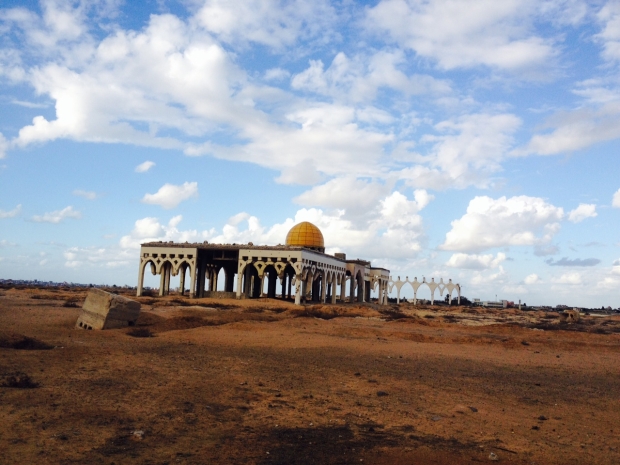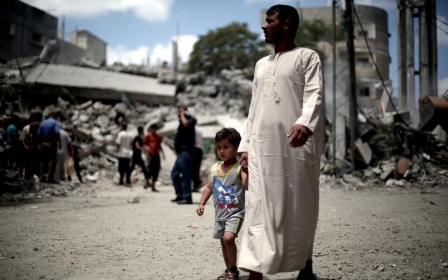Gaza airport: hopes that dreams will be a reality again
RAFAH - Gaza International Airport was a reality in 1998. Palestinian children ran to the streets to formally greet US President Bill Clinton. The airport was seen as the gateway to the world, whereby Palestinians could simply hop on a plane traveling out and return back home, freely.
The airport was known internationally by its code, GZA, after which it was renamed Yasser Arafat International Airport, in honor of a man who carried a Kalashnikov rifle in one hand and an olive branch in the other.
Some airport staff members fondly remember when a KLM flight arrived for a test, and then flew a return trip to Schiphol airport. The airport was the proud home of three Palestinian airplanes that had daily flights to Egypt, Jordan, Syria, Morocco, Cyprus and Turkey.
Issam Saleh remembers the day he traveled to Jordan on one of the flights: “It felt like a flying bus - shaking all the way -I was confused as to whether the plane was flying or landing,” he laughed, as he recalled the one-hour journey. Now, if he wants to travel, it takes weeks of preparation and paperwork. Ultimately, the success or failure of travel in Gaza depends on whether Egyptian border control authorities are willing to allow people to travel.
“But, those shaky flights were better than not being able to travel at all,” he said.
For him, the reality of that flight faded and became a distant dream. But, after all of Gaza’s sacrifices under the present Israeli assaults, he says he is determined to make such dreams a reality again.
When the second Intifada began in 2000, Israeli fighter jets first hit the flight control tower. Then bulldozers tore up the runway. And over the years, until this current Israeli assault, signs of the beautiful Moroccan-designed terminal with colorful marble - where President Arafat would receive his guests - are still faintly visible.
The project that cost $86 million has now become a place for farm animals, some alive and others dead, left in the ruins of a once-beautiful airport - chickens peck in the sand and rubble while the flights overhead are ones which never land on this runway - just Israeli F16s and drones, which continuously circle overhead, ever-watching and intimidating Gaza’s population.
Salman Abu Haleeb, head of Palestinian Aviation Authority remained hopeful - even after the airport had been bombed. He said that the Oslo Accords gave the Palestinians a right to an airport.
Indirect negotiations between Israel and Palestinian factions have failed. But among the demands of Palestinians is an open airport and seaport. Both represent dreams which were once a reality.
“This reality existed before, and I feel it will return, as long as the Palestinian resistance continues to demand,” says Abu Sadi who lives a few minutes from the airport ruins.
“I remember the days when we waved to our loved ones traveling on flights out. Now I look forward to seeing a no-fly zone for Israeli fighter jets,” he said.
Nowadays, the sea and airports have become vital obstacles for ceasefire talks, with Israel refusing both demands, because both would give more freedom and independence to Palestinians.
Israel’s airstrikes have turned the whole airport-terminal and runway into piles of gravel, remains which are now used to rebuild many homes after Israel tightened the blockade. During the ceasefires, Gazans collect up gravel left by Israel’s missiles and tank shells to try to rebuild parts of their homes.
Saleh remembers that in the old days, passengers would go through Israeli controlled crossings to have their passports stamped before boarding their flights.
“But at least there was hope, we had more of a state, and thoughts of flying made me feel free.” he said.
The Oslo Accords also allowed the construction of Gaza’s seaport. In the late 1990s, a $73 million contract was signed with European partners.
Now, Saleh says, he wants and needs to go back to Jordan for medical treatment, and calculates how many air-miles it would take to reach Amman, or get a seat. His dreams of flying are shared by others, including many young Gazan people, as a means to take break from Israel’s torment.
Gaza economist, Dr. Maher Taba’a of the Chamber of Commerce, says that a seaport and docks would allow Palestinian traders to import and export goods and materials, which would improve Gaza’s economy and give employment to over 30,000 workers.
“Today there is a chance to have a floating seaport which takes a year to be build,” he said, adding if he had to choose, as first step for Gaza economy, the seaport would be most important.
Importing through Israel since 2002 has cost Gaza’s business, trade and economy an estimated $1 billion, annually, says Taba’a according to his chamber of commerce registrations. Since then, he said, the scale of import requirements had increased five-fold at least.
A sea trip to Cyprus would take about six hours - now the talk of many young people planning what they wish and have a right to do. Palestine’s new generation has mostly never been outside, because of Israel’s occupation and restrictions on travel through Egypt and Israel. But that doesn’t stop young Palestinians from hoping for freedom of movement, like everyone else.
Dr. Taba’a says there’s no problem in external European monitoring to address Israel’s security concerns. “Gaza will be overjoyed the moment we can work and feed ourselves, freely to import and export without pain.”
He says this will make goods more affordable for the customers, and it will be a reliable source of income for the PA budget.
Meanwhile, Egyptian brokers of the suspended Cairo talks between Israel and the Palestinian factions to end the war in Gaza, have suggested that the airport and seaport demands be deferred for a second round of negotiations, in about a month.
“Once we have our open air and seaports, we can wave goodbye to aid and Palestinians can make paradise from our own air and water.”
New MEE newsletter: Jerusalem Dispatch
Sign up to get the latest insights and analysis on Israel-Palestine, alongside Turkey Unpacked and other MEE newsletters
Middle East Eye delivers independent and unrivalled coverage and analysis of the Middle East, North Africa and beyond. To learn more about republishing this content and the associated fees, please fill out this form. More about MEE can be found here.





